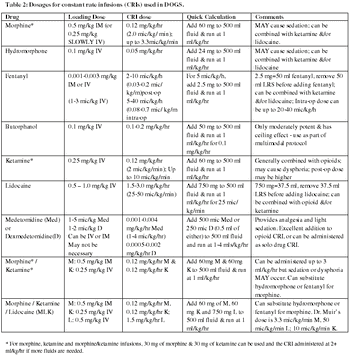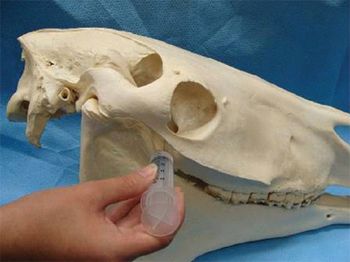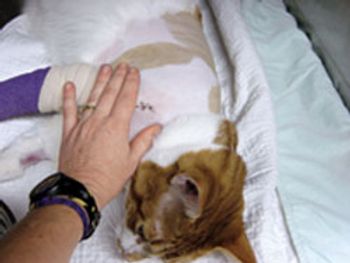
There are many medical conditions that can be quite painful, and are often forgotten in our pursuit to cure the disease. Common among these are eye pain, urinary cystitis, pancreatitis, renal uroliths, anal sac infection and acute moist dermatitis.

There are many medical conditions that can be quite painful, and are often forgotten in our pursuit to cure the disease. Common among these are eye pain, urinary cystitis, pancreatitis, renal uroliths, anal sac infection and acute moist dermatitis.

Local anesthetics were once a mainstay of pain management in veterinary medicine, and may now be one of the most under-utilized modalities. Administered locally or regionally, they are the only modality that renders complete anesthesia to a site, i.e. no transmission of nociceptive impulses as long as the drug exerts its effect.

Pain can be protective, but through the stress response it may also contribute significantly to patient morbidity and even mortality. Anxiety may contribute directly to the hyperalgesic state through cholecystikinin-mediated "nocebo" effect.

It is now a settled matter that the adaptive capacities of animals, coupled with the innate biases of human observers, seriously impairs our ability to "know" which of our patients are in pain, how much they are in pain, and sometimes, even where they are in pain. Historically the absence of behaviors easily associated with pain (crying, whimpering, etc.) has been equated with the absence of pain.

Pain can be protective, but through the stress response it may also contribute significantly to patient morbidity and even mortality. Undermanaged acute (peri-operative or post-trauma) pain can slow or even prevent recovery, and chronic pain is not merely acute pain of extended duration.

When we consider and treat the population of patients we see who are dealing with cancer, or who have a terminal disease and are approaching the ends of their lives, we are really talking about providing palliative care. This is a concept borrowed from human medicine, and is defines as any form of medical care or treatment that concentrates on reducing the severity of the symptoms associated with disease, rather than providing treatment designed to delay or reverse the progression of disease or to provide a cure.

The Controlled Substance Act was initiated to stop the diversion of narcotics, especially opioids for the purpose of abuse and misuse. Opioids are the number one cause of death in drug overdoses. The Act is aimed at giving us, the practitioner, some reasonable guidelines for ordering, storing, handling and prescribing these drugs.

It is not possible to achieve designed goals of physical rehabilitation in the canine patient without adequate pain management. Often in these patients, pain is not only generated from the original injury or trauma of surgery but also additionally from the functional impairment(s) brought about by the primary issues.

Chronic pain patients certainly present their own set of challenges beyond the obvious challenges around relieving their discomfort. We have to ensure that they eat enough, but not too much of the most appropriate nutrient profile.

In the last 10 years, the veterinary profession has undergone what can only be described as a sea change in perspectives about animal pain and pain control. A 1993 evaluation of a veterinary teaching hospital surgical caseload revealed only 40% of patients that had undergone highly invasive, painful procedures (including orthopedic repair, thoracotomy, and intervertebral disc decompression) received any sort of pain control, and then only based on clinical signs.

Cats can be difficult to safely anesthetize because of their small body size, fractious nature and altered metabolism of anesthetic drugs. Furthermore, cats are frequently undertreated for pain.

Constant rate infusions (CRI) of analgesic drugs are an excellent way to manage pain in both dogs and cats. A CRI of analgesic agents has several advantages over multiple repeated injections for pain relief.

No matter what anesthetic protocol is chosen, the addition of adequate analgesia is imperative for safe anesthesia and for enhanced patient outcome.

Our patient population has changed fairly dramatically in the last 10 years as our medical skills have progressed and we have become capable of supporting patients with advanced disease and advancing age. Now we must hone our anesthesia skills in order to support patients that largely don't fit into the 'young, healthy' category and it is no longer appropriate to think that safe anesthesia means recovering as many patients as we anesthetize.

Anesthesia should be thought of as 4 distinct and equally important periods: 1) preparation/premedication; 2) induction; 3) maintenance and 4) recovery. We tend to diminish the importance of the phases of preparation/premedication and recovery and yet these phases contribute as much to successful anesthesia as the phases of induction and maintenance.

Because the airway extends from the oral or nasal cavity to the alveoli, respiratory compromise has numerous manifestations. Complications can be encountered in both the upper and lower airways.

The most effective way to deal with anesthetic emergencies is to prevent them and appropriate 1) stabilization of the patient, 2) selection of type and dosage of anesthetic drugs, 3) preparation of anesthetic equipment, 4) pre-, post- and intra-operative support of the patient, and 4) physiologic monitoring, will make the anesthetic episode safer and will decrease the likelihood of anesthetic emergencies.

Regional or local anesthesia of the equine head greatly facilitates performing standing procedures that are anticipated to elicit pain in the patient. With effective local anesthesia, less systemic sedatives may be required for standing surgeries (e.g. dental extractions, laceration repairs, incisor avulsion repairs), patients under general anesthesia can be run at a lighter plane of anesthesia, and postoperative pain may be lessened if effective preemptive analgesia is in place.

Watch how Dr. Tim Crowe uses these three innovative tools in his critical care patients.

Can you spot the subtle signs of postoperative pain in cats?

Topical ophthalmic proparacaine can also be applied to small wounds for quick pain control.

With this pain management modality, promoting healing and your bottom line is a zap.

How you can help alleviate the pain for pets with cancer.

Treating pain is a fundamental part of practicing good medicine.

This anesthetic agent can improve patient experience, boost client compliance.